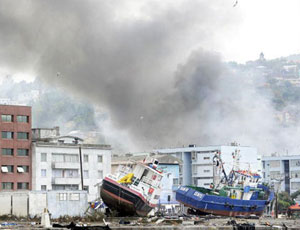Hours after Chile was hammered on Feb. 27 by one of the most powerful earthquakes in its history, President Michelle Bachelet made it clear the country already is preparing for recovery.

“We are facing a catastrophe of unforeseen magnitude which caused damage that will require enormous efforts of all sectors of the country, private and public, not only now but for one very important time ahead,” Bachelet said in her first public statement following the disaster.
The damage to Chile’s infrastructure and industrial sector from the magnitude-8.8 earthquake initially prompted economists to fret over the country’s financial future and question if the country would be able to sustain its recent growth. The most pessimistic estimate suggests damages from the quake could cost as much as 15% of the country’s GDP.
Of primary concern is the mining industry, the backbone of Chile’s industrial base. Two of the country’s largest copper mines, El Teniente and Andina, were shut down after the quake. They were able to resume operations within 48 hours, but analysts remain concerned that power shortages and road and rail damage may curtail output.
Despite the immediate worries, analysts were optimistic about Chile’s long-term prospects. The country’s strong financial footing, as well as its reputation as one of the most transparent, safe and stable countries in Latin America, bode well for its ability to emerge from the disaster in reasonably good shape, analysts say.
Credit Suisse noted that “Chile has ample resources abroad to help finance the cost of its rebuilding efforts” and that the country would be able to turn to debt markets for additional support.
The buoyancy of the copper market also ensures Chile’s $4-billion economic stimulus effort—started in January of 2009 and the largest ever undertaken by the country—will continue to be financed. That plan depended on earnings from the sovereign wealth funds, which are bolstered by copper mining.
Optimism about Chile’s prospects for recovery stand in stark contrast to the ongoing struggles of Haiti to handle the devastation from a magnitude-7 earthquake in January. That disaster claimed more than 220,000 lives, left more an a million homeless and has affected more than three million residents. The government estimates 250,000 residences and 30,000 commercial buildings were severely damaged and must be demolished.
In a report released last year, Christian Jaramillo with the University of the Andes in Bogota, Colombia, found that most countries are able to rebound economically from a major disaster after a few years when recovery measures begin to kick in.
“Only a few countries that have a history of devastating disasters suffer lasting lower growth,” Jaramillo said. “Haiti has one such history; Chile does not. Chile has suffered severe disasters, but it was not devastated by them.”
Examining disasters occurring in more than 100 countries over a 36-year span, Jaramillo found that reconstruction efforts begin showing a measurable degree of GDP growth within two to five years. Yet a small number of countries, such as Haiti, with a history of highly devastating disasters, endure permanent negative effects.
The economic disparity between the two nations vividly illustrates the difference. Haiti is the poorest country in the Western Hemisphere, with a GDP of just $11.53 billion in 2008. The island nation is ranked 149th of 182 countries on the UN’s Human Development Index. Chile comes in 44th on the index and had a $169.5 billion GDP in 2008.
“A history of devastating disasters probably reflects bad institutions,” Jaramillo said. “If you are caught unprepared once, that’s bad luck. If you are caught so several times, your institutions lack the ability to deploy preventive and palliative measures,” he said.














Post a comment to this article
Report Abusive Comment